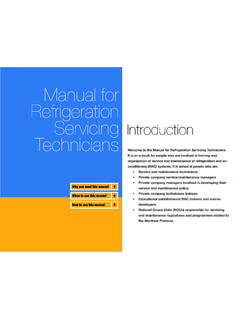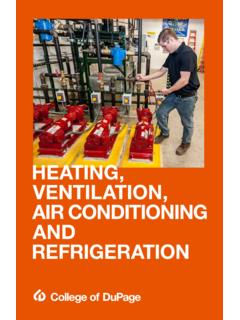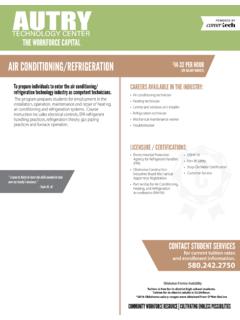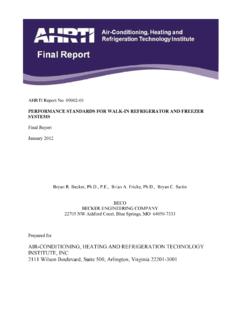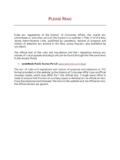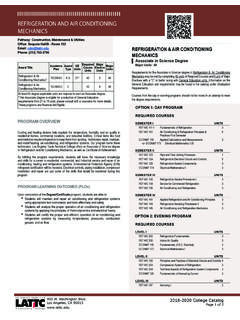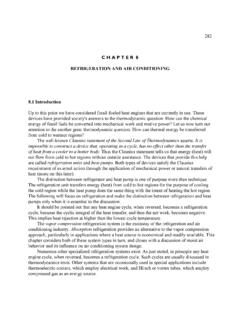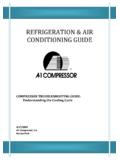Transcription of REFRIGERATION AND AIRCONDITIONING - …
1 REFRIGERATION AND AIRCONDITIONING 2 DEGREE COURSE SCHEME AND SYLLABI (2002-03 ADMISSION ONWARDS) MAHATMA GANDHI UNIVERSITY KOTTAYAM,KERALA REFRIGERATION AND air conditioning M 703 2+1+0 Module 1 Principles of REFRIGERATION : Thermodynamics of REFRIGERATION - Carnot cycle, reversed carnot cycle, heat pump, and refrigerating machine- coefficient of performance - unit of REFRIGERATION - REFRIGERATION methods- conventional REFRIGERATION systems. Air REFRIGERATION system- Bell Coleman cycle - capacity work and refrigerant flow requirements in Bell - Coleman cycle.
2 Module 2 Vapour compression system: simple cycle -comparison with Carnot cycle - theoretical, actual and reactive - COP effect of operating parameters on COP - wet, dry and superheated compression - under cooling - actual cycle representation on TS and PH diagrams simple problems. Advanced vapour compression systems - multistage vapour compression systems - flash chamber multiple compression and evaporation systems cascading - simple problems. Module 3 Vapour absorption systems: simple, cycles - actual cycle - ammonia water and lithium bromide water systems - COP - electrolux system.
3 Refrigerant and their properties: Nomenclature - suitability of refrigerants for various applications - unconventional REFRIGERATION methods- Vortex tube, steam-jet, magnetic (cryogenics) REFRIGERATION and thermoelectric REFRIGERATION - applied REFRIGERATION house hold refrigerators - unit air conditioners and water coolers - ice plant cold storage. 3 Module 4 REFRIGERATION system components: condensers - water and air cooled condensers - evaporative condensers - expansion devises - capillary tube- constant pressure expansion valve - thermostatic expansion valve - float valve and solenoid valve - evaporators - natural convection coils - flooded evaporators - direct expansion coils.
4 Reciprocating compressors: single stage and multistage compressors - work done optimum pressure ratio- effect of interfolding - volumetric efficiency -effect of clearance - isothermal and adiabatic efficiency - compressed air motors. Rotodynamic compressors: Screw and vane type compressors - principle of operation - hermetic, semihermetic and open type REFRIGERATION compressors. Module 5 Principles of air conditioning : Psychrometry and psychrometric chart thermodynamics of human comfort - effective temperature - comfort chart applied psychrometry - sensible heat factor - psychometric process-problems.
5 Winter air conditioning : heating load calculations humidifiers and humidistat. Summer air conditioning : cooling load calculations - year round air conditioning - unitary and central systems - principles of air distribution - design of air duct systems. References 1. REFRIGERATION and air conditioning - Ballaney P. L. 2. REFRIGERATION and air conditioning - Stocker W. F. 3. REFRIGERATION and air conditioning - Jordan and Protester 4. Principles of REFRIGERATION - Roy J. Dossat 4 MODULE I Air REFRIGERATION Cycles Introduction In an air REFRIGERATION cycle, the air is used as a refrigerant.
6 In olden days, air was widely used in commercial applications because of its availability at free of cost. Since air does not change its phase remains gaseous throughout the cycle, therefore the heat carrying capacity per kg of air is very small as compared to vapour absorbing systems. The air-cycle REFRIGERATION systems, as originally designed and installed, are now practically obsolete because of their low coefficient of performance and high power requirements. However, this system continues to be favoured for air REFRIGERATION because of the low weight and volume of the equipment.
7 The basic elements of an air cycle REFRIGERATION system are the compressor, the cooler or heat exchanger, the expander and the refrigerator. Before discussing the air REFRIGERATION cycles, we should first know about the unit of REFRIGERATION , coefficient of performance of a refrigerator and the difference between the heat engine, a refrigerator and a heat pump. Units of REFRIGERATION The practical unit of REFRIGERATION is expressed in terms of tonne of REFRIGERATION (briefly written as TR). A tonne of REFRIGERATION is defined as the amount of REFRIGERATION effect produced by the uniform melting of one tonne (1000 kg) of ice from and at 0oC in 24 hours.
8 Since the latent heat of ice is 335 kJ/kg, therefore one tonne of REFRIGERATION , ITR = 1000 335 kJ in 24 hours = 1000 kJ/min24 60 In actual practice, one tonne of REFRIGERATION is taken as equivalent to 210 kJ/min or kW ( kJ/s) 5 Coefficient of Performance of a Refrigerator The coefficient of performance (briefly written as ) is the ratio of heat extracted in the refrigerator to the work done on the refrigerant. It is known as theoretical coefficient of performance. Mathematically, Theoretical = QW where Q = Amount of heat extracted in the refrigerator (or the amount of REFRIGERATION produced, or the capacity of a refrigerator), and W = Amount of work done.
9 Notes: 1. For per unit mass, = qw 2. The coefficient of performance is the reciprocal of the efficiency ( 1/ ) of a heat engine. It is thus obvious, that the value of is always greater than unity. 3. The ratio of the actual to the theoretical is known as relative coefficient of performance, Mathematically. Relative = Actual Example Find the of a REFRIGERATION system if the work input is 80 kJ/kg and REFRIGERATION effect produced is 160 kJ/kg of refrigerant flowing. Solution. Given : w = 80 kJ/kg ; q = 160 kJ/kg We know that of a REFRIGERATION system = qw = 16080 = 2 Ans.
10 Difference Between a Heat Engine, Refrigerator and Heat Pump In a heat engine, as shown in Fig. (a), the heat supplied to the engine is converted into useful work. If Q2 is the heat supplied to the engine and Q1 is the heat rejected from the engine, then the net work done by the engine is given by 6 WE = Q2 - Q1 Fig. Difference between a heat engine, refrigerator and heat pump. The performance of a heat engine is expressed by its efficiency. We know that the efficiency or coefficient of performance of an engine, E or ( )E = Work doneHeat sup plied = E2WQ = 212 QQQ A refigerator as shown in (b), is a reversed heat engine which either cool or maintain the temperature of a body (T1) lower than the atmospheric temperature (Ta).
